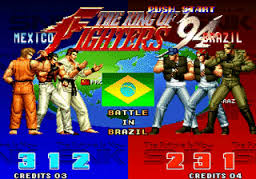Since the release of the Super Famicom in 1990, fans of the series had been eagerly waiting for a 16-bit version of Rockman. Rockman/Megaman X would finally see the light of day in 1993.
Set over 100 years in the future, the game would mark the introduction of Rockman X, more commonly known as X in his quest to join the Maverick Hunters, an elite team sent to dispatch a series of new robot masters.
Game-play in Rockman X was fluid and the game was one of the best playing games on the SFC/SNES. The introduction of armour upgrades and a timed charge shot brought new life into the series. Rockman X's music was another highlight. Great sales signified that Rockman was indeed back in a big way.
In development around the same time as Rockman X, Rockman 7 was a more traditional approach to a 16-bit Rockman game. Again featuring Dr. Wily, it was basically an NES/Famicom Rockman game with a fresh coat of paint. Little innovations were introduced. Besides a "Rush" search feature (you could have Rush search for items), very little new features were added. Two new characters, Forte (Bass in the West) and Gospel (Treble in the West) made cameos. Soon, Forte and Rockman would star in their own game. Rockman 7 was a solid game, but peeled back some of the innovations that the Rockman X series made. Today, the game is rarely discussed and is fairly rare.
Shortly before Rockman 7, Rockman X2 arrived in late 1994. Featuring a specialized co-processor (the Cx4), the game even featured some pseudo-3D effects. While the core gameplay remained the same as Rockman 7, the new graphical features, vehicular missions, power-ups, and even a dragon-punch from Street Fighter meant that the game offered enough fresh elements. The game was well-received but was not see as fresh and innovative as the original Rockman X. On an interesting note, the Cx4 chip has been causing havoc on emulators for years, being a harder chip to emulate for some emulators.
Rockman X3 would see release on both the 16-bit SFC/SNES and Playstation and Saturn in 1995. A polarizing sequel, many consider it to be the best in the Rockman X series. This time, Rockman comrade "Zero" was finally playable. While not featuring many graphical upgrades, the 32-bit versions of the games had "redbook" CD audio. The game arrived during the transition between the 16 and 32-bit eras. It remains a fairly obscure title today, fetching a huge sum of money for the SFC/SNES version of the game.

With the introduction of the 32-bit consoles, fans wondered what was next for the blue bomber. Released in 1996, Rockman 8 was released on the Playstation and Sega Saturn. Similar to Rockman 7 in terms of style and game-play, the game was fairly traditional in terms of the Rockman series. One new element was the addition of animated cutscenes. While they may have looked nice, the English voice acting was highly criticized for its low-quality. For many, the Saturn version is considered superior due the 2D power of the system.
Strangely enough, There would be one more release on Nintendo's 16-bit hardware after Rockman 8. Rockman and Forte was one of the last games released for the dying Super Famicom in 1998. While many welcomed the ability to play as Forte (Bass) and the game's great graphics, its high difficulty and recycling of enemies and sprites from Rockman 8 meant that not everyone was pleased with the game. With the Super Nintendo already dead, the game would not see official release in North American until a GBA port in 2002.
The association between Nintendo and the early Rockman/Megaman games is very clear. However, Sega would secure a couple different releases for their hardware. In 1994, "Rockman: Mega World" would see releases on the Sega Mega Drive. A compilation/reworking of the first three NES/Famicom games, a PAL release (known as Mega Man: The Wily Wars) would see releases in Europe in 1995. The game would never be officially released on cartridge in North America, only seeing release on Sega's "Sega Channel" subscription service. Solid ports, it is a shame that many in North America have never played the game.
Around this time, Rockman would also see several hand-held releases. Five games would appear on Nintendo's Gameboy during the early 1990s. While not as popular or famous and the home console versions, the portable games were fun and exciting, featuring bosses from the main series and even some unique bosses. In North America only, a semi-port of Megaman 4 was released for the Sega Game Gear in 1995.



















































